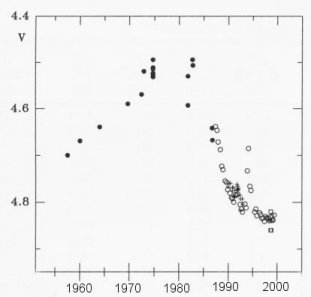
 |
Pi Aquarii, a "B-emission" star that possesses an unstable extended equatorial disk, varies by several tenths of a magnitude (visual magnitude, "V") over an observed interval of 40 years. Most, if not all, of the variations are the result of the disk and a fierce, variable wind. From a paper in the Astrophysical Journal, vol. 573, p. 812, 2002, by K. S. Bjorkman, A. S. Miroshnichenko, D. McDavid, and T. M. Pogrosheva (including data from D. McDavid, Publ. Astro. Soc. Pacific, vol. 11, p.494, 1999). |